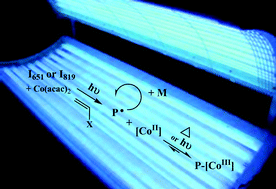The input of photochemistry to the Co(acac)2 mediated radical polymerization (CMRP) of n-butyl acrylate and vinyl acetate is investigated for the first time. Upon UV irradiation, photoinitiators are able to initiate the n-butyl acrylate polymerization that remains controlled up to very high molar masses (>4 × 106 g mol−1) with low polydispersities. The photoinitiator as well as the irradiation time must be appropriately chosen to reach acceptable initiator efficiencies while maintaining an optimal control over the polymerization. Laser flash photolysis experiments were then carried out to evidence the addition of alkyl and phosphonyl radicals onto Co(acac)2 and to determine the rate constants (kdeact) of these addition reactions that were still lacking. Finally, both kinetics of polymerization and spin-trapping experiments have evidenced that the C–Co bond at the extremity of the dormant polymer chains can be easily photocleaved. UV irradiation can therefore be considered as an additional lever for tuning the reactivity of the CMRP process mediated by Co(acac)2.
